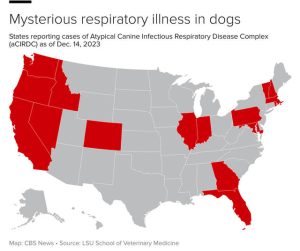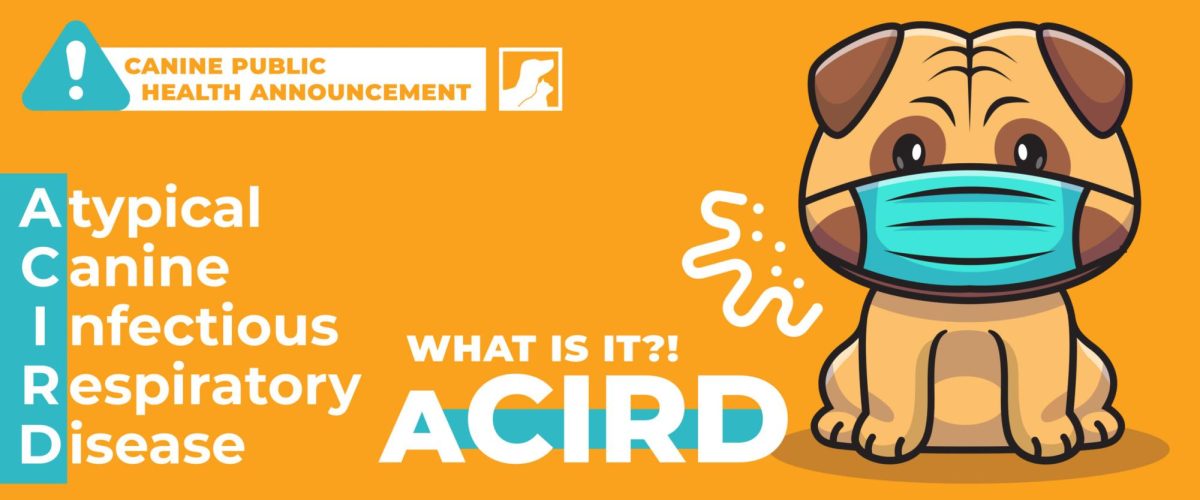A mysterious new K9 dog illness is spreading across the United States. It is known to be contagious, with symptoms including prolonged coughing, eye/nose discharge, lethargy, sneezing, labored breathing, and pneumonia that can occasionally become serious enough to lead to death. These are all symptoms that have occurred in other canine illnesses such as kennel cough syndrome, but the symptoms of this affliction seem to last for much longer.
As this sickness has shown to be resistant to standard treatments and does not result in positive tests for common respiratory pathogens, it is simply being grouped as an atypical canine infectious respiratory disease (aCIRD) until the causative agent is discovered.
The first known case of this virus was in Oregon, which has since then become a hot-spot for it, reporting at least 200 cases centering around the Portland Area. The US Department of Agriculture’s Animal and Plant Health Inspection Service states that it is “currently working with multiple state animal health officials and diagnostic laboratories regarding reports of respiratory illness in dogs that, in rare cases, has progressed rapidly to death.”
 However, tracking this illness is not as easy as tracking human illnesses are as there is no one group dedicated to it. Despite this, according to the most recent reports, this aCIRD has been found to have spread to at least sixteen states, including California, Colorado, Florida, Georgia, Maryland, Massachusetts, New Hampshire, Oregon, Rhode Island, and most recently, Vermont, Nevada and Pennsylvania.
However, tracking this illness is not as easy as tracking human illnesses are as there is no one group dedicated to it. Despite this, according to the most recent reports, this aCIRD has been found to have spread to at least sixteen states, including California, Colorado, Florida, Georgia, Maryland, Massachusetts, New Hampshire, Oregon, Rhode Island, and most recently, Vermont, Nevada and Pennsylvania.
Many people and organizations are attempting to trace back the cause of this illness. One of these people is Dr. David Needle, the chief pathologist at the diagnostics lab of the University of New Hampshire. From a batch of test samples from the New England area, his team isolated a “weird bacterium,” as it was smaller than a normal bacterium and it did not have a cell wall. At this point in the research, Dr. Needle proposed that the most likely source of this illness seems to be a member of “the normal community of bacteria and other microorganisms that live in the respiratory tract,” but had developed a “virulence-associated gene/trait.” However, before this hypothesis can be confirmed, the university needs to compare these samples to a much bigger pool.
As mentioned before, this aCIRD is highly contagious. Prevention methods include steering clear of places where your dog may come into contact with many others, such as a vet, a groomer, or a dog park. Other tips include wiping your dog’s nose and paws when they come back from a walk and not letting them use the same toys or bowls as other dogs.
This virus is something that pet owners should be aware of, but many dogs have recovered and there is additionally no indications of this virus being zoonotic, passing from animals to humans. As such, the experts recommend caution and taking precautionary measures, but there is no need to worry or panic at this preliminary stage.
Sources:
https://www.nbcnews.com/health/health-news/mysterious-dog-illness-pet-research-vet-treatment-rcna127505
https://www.usatoday.com/story/graphics/2023/12/04/what-is-dog-respiratory-illness-symptoms/71753397007/





















